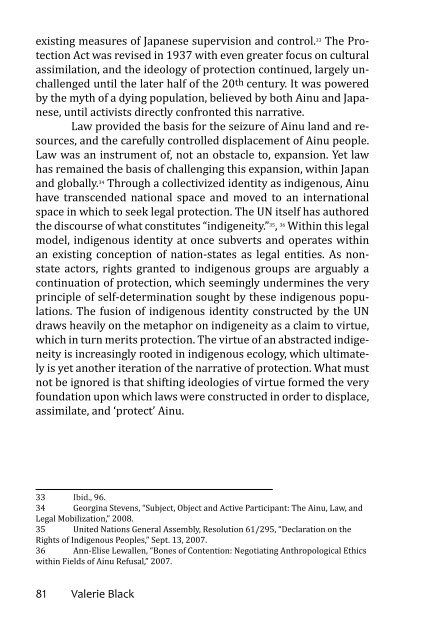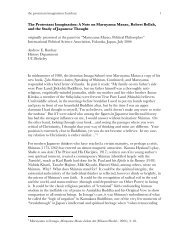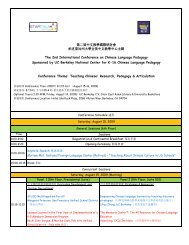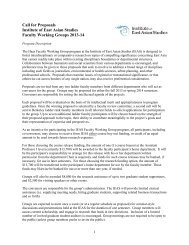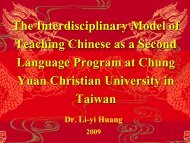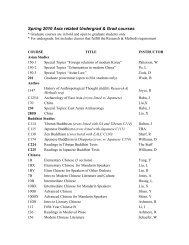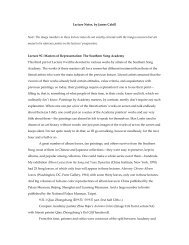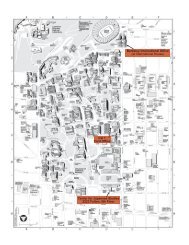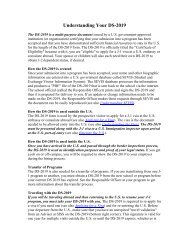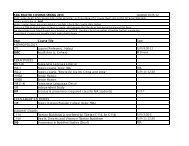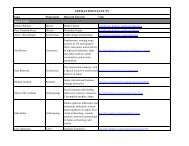Third Edition Spring 2013 - Institute of East Asian Studies, UC ...
Third Edition Spring 2013 - Institute of East Asian Studies, UC ...
Third Edition Spring 2013 - Institute of East Asian Studies, UC ...
Create successful ePaper yourself
Turn your PDF publications into a flip-book with our unique Google optimized e-Paper software.
existing measures <strong>of</strong> Japanese supervision and control. 33 The ProtectionAct was revised in 1937 with even greater focus on culturalassimilation, and the ideology <strong>of</strong> protection continued, largely unchallengeduntil the later half <strong>of</strong> the 20th century. It was poweredby the myth <strong>of</strong> a dying population, believed by both Ainu and Japanese,until activists directly confronted this narrative.Law provided the basis for the seizure <strong>of</strong> Ainu land and resources,and the carefully controlled displacement <strong>of</strong> Ainu people.Law was an instrument <strong>of</strong>, not an obstacle to, expansion. Yet lawhas remained the basis <strong>of</strong> challenging this expansion, within Japanand globally. 34 Through a collectivized identity as indigenous, Ainuhave transcended national space and moved to an internationalspace in which to seek legal protection. The UN itself has authoredthe discourse <strong>of</strong> what constitutes “indigeneity.” 35 , 36 Within this legalmodel, indigenous identity at once subverts and operates withinan existing conception <strong>of</strong> nation-states as legal entities. As nonstateactors, rights granted to indigenous groups are arguably acontinuation <strong>of</strong> protection, which seemingly undermines the veryprinciple <strong>of</strong> self-determination sought by these indigenous populations.The fusion <strong>of</strong> indigenous identity constructed by the UNdraws heavily on the metaphor on indigeneity as a claim to virtue,which in turn merits protection. The virtue <strong>of</strong> an abstracted indigeneityis increasingly rooted in indigenous ecology, which ultimatelyis yet another iteration <strong>of</strong> the narrative <strong>of</strong> protection. What mustnot be ignored is that shifting ideologies <strong>of</strong> virtue formed the veryfoundation upon which laws were constructed in order to displace,assimilate, and ‘protect’ Ainu.33 Ibid., 96.34 Georgina Stevens, “Subject, Object and Active Participant: The Ainu, Law, andLegal Mobilization,” 2008.35 United Nations General Assembly, Resolution 61/295, “Declaration on theRights <strong>of</strong> Indigenous Peoples,” Sept. 13, 2007.36 Ann-Elise Lewallen, “Bones <strong>of</strong> Contention: Negotiating Anthropological Ethicswithin Fields <strong>of</strong> Ainu Refusal,” 2007.Ethnography, Bodies, and ResistanceThe relationship between Ainu <strong>Studies</strong> and Ainu activismreveals the complexity <strong>of</strong> the politics <strong>of</strong> indigeneity, particularlythe ambiguous division <strong>of</strong> academics and activism. Howell suggeststhat a ‘neutral’ perspective is not only possible, but ideal. Yet, thedynamic <strong>of</strong> positioning academia as separate and removed fromthe sphere <strong>of</strong> activism originates in the production <strong>of</strong> cultural hierarchies.As anthropology and other social sciences contemplatemodels <strong>of</strong> ‘engaged’ or ‘applied’ studies, it is important to ask, whatconstitutes an ‘unengaged’ model? Arguably, the myth <strong>of</strong> neutralitythat permeated the early formation <strong>of</strong> social sciences continuesunchecked. Instead, the ownership <strong>of</strong> knowledge, and <strong>of</strong> perceivedsources <strong>of</strong> knowledge, bear close resemblance to patterns <strong>of</strong> colonization,and the assumed privilege <strong>of</strong> studying the inferior ‘other.’The disputed ownership <strong>of</strong> this knowledge and the formation <strong>of</strong>Ainu as subjects make past and present Ainu <strong>Studies</strong> a site <strong>of</strong> activistresistance.In Bones <strong>of</strong> Contention: Negotiating Anthropological Ethicswithin Fields <strong>of</strong> Ainu Refusal, anthropologist Ann-Elise Lewallendescribes the history <strong>of</strong> Ainu scholarship itself in relation to Ainuas subjects. 37 She addresses the interaction <strong>of</strong> activism and scholarship,including the logistical issues <strong>of</strong> conducting ethnographic researchrequiring written consent within a culture where oral communicationis dominant, and where written communication bearsovertones <strong>of</strong> exploitation and oppression. 38 She also observes thelegacies <strong>of</strong> Ainu mistrust produced within Ainu <strong>Studies</strong>, includingthe extraction <strong>of</strong> cadavers from Ainu burial sites, and the history <strong>of</strong>‘scientific’ testing on living Ainu subjects. Quite literally, the bodies<strong>of</strong> Ainu were employed to uphold the scientific racism promoted inthe 19th century.Drawing on her experiences <strong>of</strong> being rejected by Ainu communitiesdue to her identity as an anthropologist, Lewallen con-37 Ibid.38 Ibid.81 Valerie Black Ainu Indigeneity 82


